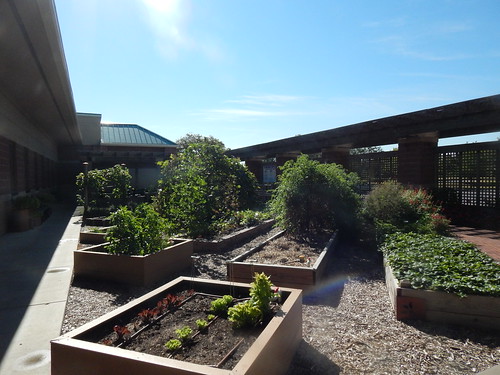Blog Archives
Growing squash – problems and solutions
Squash plants love the hot summer sun, and Kansas has plenty of it! Any vegetable gardener in the state who has been growing for very long will likely have planted some variety of squash. There are a few issues that can pop up when growing squash, but overall, it is usually pretty easy to grow.

In the Demo garden, we are growing both summer squash and winter squash. Contrary to what the names imply, both types of squash are grown during the heat of summer; one main difference is that summer squash is grown for its young or immature fruit (think zucchini), while winter squash is grown for its fully mature fruit, so it takes longer to be ready (think butternut squash or pumpkins).
Summer squash grows in a bushy shape and is generally ready to harvest by mid-summer. When harvested at small sizes, they have a soft, thin skin and unsubstantial seeds and can be eaten raw. If left on the plant to grow very large, though, they become tough and too bitter to eat raw. The most popular types of summer squash are zucchini and yellow squash, but other types include pattypan and tromboncino.
We have two varieties of summer squash in the demo garden, and both are varieties of zucchini: ‘49er’ and ‘Astia,’ which both are beginning to yield a harvest.
‘49er’ is a yellow zucchini which has about 50 days to maturity (DTM), and ‘Astia’ is a dark green zucchini with 48 DTM. Both are best harvested at about 5-6 inches long. (Yellow squash and yellow varieties of zucchini are similar, but different; zucchini maintains a relatively consistent diameter, whereas yellow squash is broader at one end and tapers toward the other, and often has a slightly thicker skin than zucchini.)


Winter squash generally has a vining nature and needs either lots of space to sprawl out or a trellis to grow vertically when space is at a premium. Because it is harvested when fully mature, it has a tougher skin than summer squash that is not usually eaten. Winter squash is usually ready to harvest late summer or early fall. One of the benefits of growing winter squash is that it can store well, even through the winter months. The winter squash in the demo garden (‘Waltham’ butternut and ‘Autumn Frost’ acorn squash varieties) are setting fruit but won’t be ready to harvest for several more weeks. We’ll keep you posted!
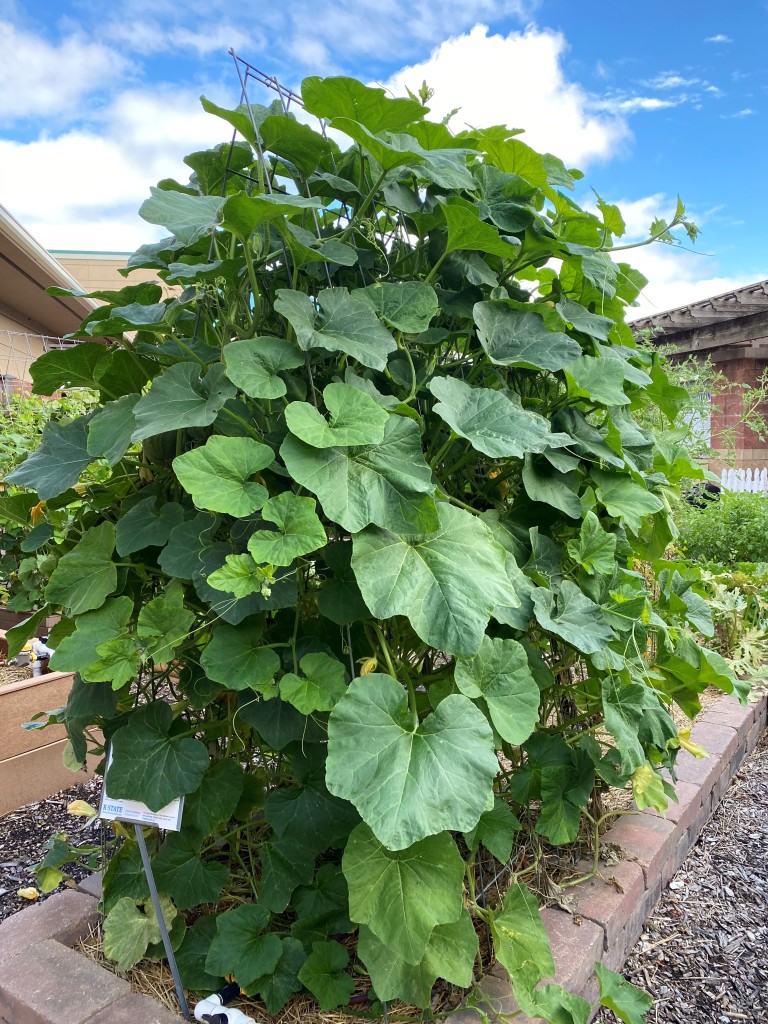

A couple of the biggest challenges with growing squash are the squash vine borer and the squash bug. Both of these insects can wreak significant havoc and are taking their toll now in the Demo garden.
The classic symptom of squash vine borer is a wilted plant when the plant has been watered well and shouldn’t be drooping. Upon closer inspection, you may be able to see that the stem has small holes or is chewed up close to the ground with larvae frass at the base. At this point, it is important to remove the larvae by either disposing of the plant completely, or, if you’re feeling surgical, slitting the vine with a sharp knife until you find the larvae and then removing it. The slit vine can be placed back in the soil and kept moist in the hopes that it will send off new roots, but some plants may have been damaged beyond repair and won’t recover from the “surgery.” If the larvae are not removed and are allowed to complete their life cycles in your garden (in which they eat their way out of the stem, burrow 1-2 inches into the soil, and wait in a cocoon until the next season), the problem will likely return next year. Once you have squash vine borers, there is not a whole lot you can do; to learn about treatment options and cultural controls, see this helpful publication.


Another pest we are facing in the Demo garden is squash bugs. Adults look similar to stink bugs and can be found on many species of the cucurbit family, but squash is their favorite. Adults and nymphs (which are lighter grey with black legs) cause damage by sucking out juices from plant leaves, resulting in yellowing, wilting, and death of the plant when populations are large. Squash bug eggs can be found by scouting on the under sides of leaves – they are glossy brown and laid in groups in between leaf veins. These eggs can be scraped off and disposed of to help control, but here in the Demo garden, the problem has passed the egg stage, and we have begun chemical control to limit the damage. Squash bugs are best controlled at the nymph stage, since adults have a hard shell that protects them from pesticides. We have applied one round of spinosad by spraying it on the vine and branches where the nymphs are congregating. We won’t be able to harvest zucchini for at least three days after spraying, and depending on what the squash bug population looks like after the application, we may spray again in about a week. We use chemicals sparingly in the Demo garden, which are safe when used appropriately. As always… when using chemical pesticides, make sure read and follow the label! To learn more about squash bugs, click here.


One last issue we had with the zucchini earlier this year was small fruit (around 3 inches) that shriveled up or rotted from the blossom end of the fruit before coming to harvestable size. This symptom can be due to a couple of different culprits, but is ultimately related to an issue with pollination.


Sometimes high temperatures following a mild or cool spell can limit the number of pollinators that are active in the garden; sometimes over-fertilization (high nitrogen levels) in the soil can cause the plant to produce too many male flowers; and sometimes plants don’t produce enough male and female flowers at the same time to ensure enough pollination (this issue usually resolves itself as the season progresses.)
We stepped in to lend our zucchini plants a pollinating hand, and you can too if you see this issue in your garden – it is as simple as taking the pollen from the male flowers and transferring it to the female flowers. First, identify which flowers are female and which are male; female flowers often have a swelling behind the flower head where the fruit is barely beginning to form, whereas male flowers have a straight stem behind the flower head. Another, perhaps more reliable way to tell is to look inside the flower: the female has a stigma which is larger and slightly round or bulbous, and the male has a single, straight appendage – the anther – inside the flower.

Hand-pollinating can easily be done by using a small artist-sized paint brush to transfer pollen from the male to the female flowers; lightly touch the tip of the brush to the anther on a male flower and dab the pollen that the brush picked up onto the stigma of a female flower.
With a couple hand-pollinating sessions, a relative evening-out of temperature, and an uptick in pollinators in the garden, our zucchini are now producing harvestable fruit. Now it’s a matter of fending off the squash bugs so that we can keep harvesting this delicious summer garden staple!
Resources for further reading:
By: Maureen Wilbeck, Master Gardener
Grocery Garden Harvest Report – July & August
How time flies when it’s summer and there’s lots of produce! It has been two whole months since I updated you on the harvests, yields, and value of the Grocery Garden bed.

July:
Venice Beans: 3.175 lbs @ $4.00 per lb = $12.70
Purple Dragon Carrots:7.85 bunches @ $3.00 per bunch = $23.55
Yellow Carrots: 7.5 bunches @ $3.00 per bunch = $22.50
Cylindra Beets: 4.5 bunches @ $3.00 per bunch = $13.50
Gold Beets: 0.3 bunches @ $3.00 per bunch = $0.90
Red Marble Onion: 0.99 lbs @ $1.50 per lb = $1.48
Bride Eggplant: 0.675 lb @ $5.99 per lb = $4.04
Esterina Cherry Tomato: 2.025 lbs @ $4.00 per lb = $8.10
July Total: $86.77
August:
Bride Eggplant: 2.56 lbs @ $5.99 per lb = $15.34
Esterina Cherry Tomato: 5.25 lbs @ $4.00 per lb = $21.02
Escamillo Pepper: 14 peppers @ $1.25 per each = $17.50
Red Knight Pepper:3 peppers @ $1.25 per each = $3.75
Spaghetti Squash: 7.80 lbs @ $1.50 per lb = $11.70
August Total: $69.31
Year to Date Total: $276.28
As you can see, we’ve had some great yields on many things and decent yields on others. However, our total value continues to pile up. Over $275 from 100 sq. ft is pretty good! And we have been planting for fall, so there is more still to come.
Friday PhotoEssay – October 9, 2015
I wonder if anyone has done a study looking at the relationship between the ugliness of a tomato plant and its productivity? Our tomato plants are UGLY, but the number of tomatoes we are still getting from them is a little bit ridiculous.
 We are slowly taking a few more plants out as they die. Our squash vines are starting to die back as well, but we won’t remove them for a couple more weeks. Past experiences tell us that trying to remove live vines from our cattle panel trellises is extremely difficult. Dead vines are much easier to deal with. Sometimes I’ve even had to cut the vines off at the ground and let them dry for a week before we can take everything down.
We are slowly taking a few more plants out as they die. Our squash vines are starting to die back as well, but we won’t remove them for a couple more weeks. Past experiences tell us that trying to remove live vines from our cattle panel trellises is extremely difficult. Dead vines are much easier to deal with. Sometimes I’ve even had to cut the vines off at the ground and let them dry for a week before we can take everything down.
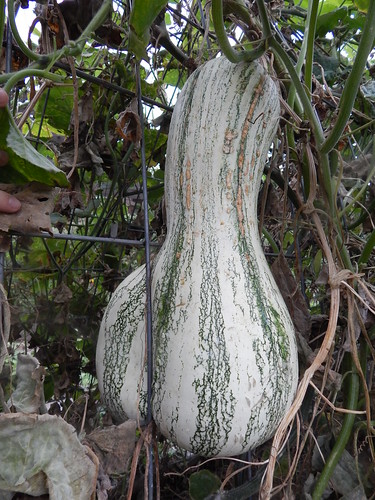 One of our projects this week was to extract this Green Striped Cushaw from where it had grown through the trellis. It took a big knife!
One of our projects this week was to extract this Green Striped Cushaw from where it had grown through the trellis. It took a big knife!
 We buried the knife! We cut the back part of the squash off, then had to trim it a bit more before pulling the other part off the trellis.
We buried the knife! We cut the back part of the squash off, then had to trim it a bit more before pulling the other part off the trellis.
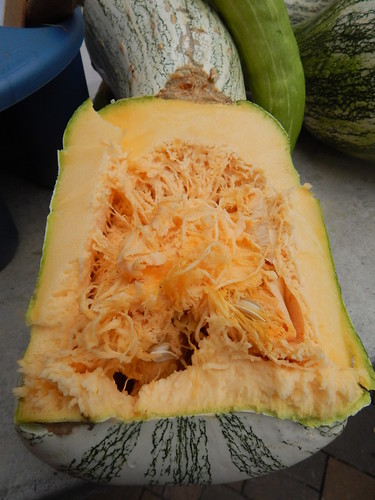 That’s one way to get a square squash!
That’s one way to get a square squash!
 This lettuce plant went and bolted this week. I’m not really sure why. I suspect that the weather fluctuations probably played the biggest role in it.
This lettuce plant went and bolted this week. I’m not really sure why. I suspect that the weather fluctuations probably played the biggest role in it.
 I know, I know…obligatory Swiss Chard photo for the week! I had to change it up with the yellow chard instead of the red.
I know, I know…obligatory Swiss Chard photo for the week! I had to change it up with the yellow chard instead of the red.
Have a great weekend!
Friday PhotoEssay – October 2, 2015
It’s October and all of a sudden the weather also feels like October! Not a lot to report on from the Demo Garden this week, although I did harvest a squash today and the Master Gardeners harvested quite a few beans, greens, and tomatoes earlier in the week.
There has not been much change in the overall look of the garden this week from last week.
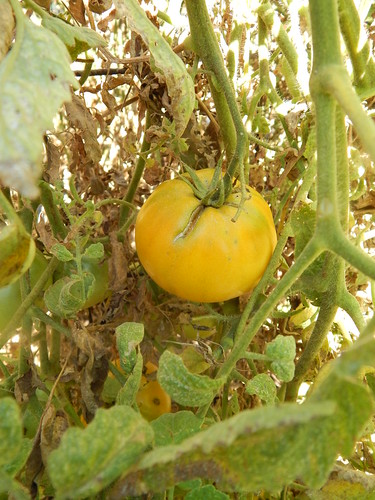 That said, as ugly as most of our tomato plants are, they are still quite productive. The ‘Chef’s Choice Orange’ was an All America Selection this year and is definitely living up to its reputation with all the late season tomatoes. This variety was rated highly in my earlier review post and it is only increasing in my estimation.
That said, as ugly as most of our tomato plants are, they are still quite productive. The ‘Chef’s Choice Orange’ was an All America Selection this year and is definitely living up to its reputation with all the late season tomatoes. This variety was rated highly in my earlier review post and it is only increasing in my estimation.
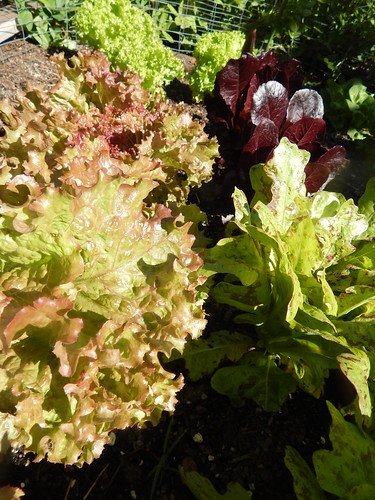 Our fall lettuces continue to shine. The front left lettuce is ‘New Red Fire’ (leaf lettuce). The far back left variety is ‘Muir’ (leaf lettuce). The back right variety is ‘Thurinus’ (red romaine). The front right lettuce is ‘Flashy Butter Oak’ (oak leaf lettuce).
Our fall lettuces continue to shine. The front left lettuce is ‘New Red Fire’ (leaf lettuce). The far back left variety is ‘Muir’ (leaf lettuce). The back right variety is ‘Thurinus’ (red romaine). The front right lettuce is ‘Flashy Butter Oak’ (oak leaf lettuce).
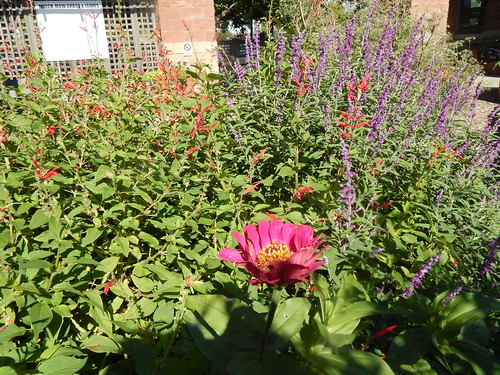 Our Herb & Pollinator Garden hasn’t been as spectacular this year as it was last year, until all of a sudden the Mexican Bush Sage, Pineapple Sage, and Zinnias have burst into bloom. I guarantee you that no picture I take is as beautiful as it is in person, so come check it out!
Our Herb & Pollinator Garden hasn’t been as spectacular this year as it was last year, until all of a sudden the Mexican Bush Sage, Pineapple Sage, and Zinnias have burst into bloom. I guarantee you that no picture I take is as beautiful as it is in person, so come check it out!
 I broke down and harvested this squash/pumpkin, the ‘Thai Kang Kob’ this morning. The rind wasn’t as hard as I would have liked, but there was a crack around the stem that was starting to rot and let bugs in. Watch for more on this lovely specimen next week!
I broke down and harvested this squash/pumpkin, the ‘Thai Kang Kob’ this morning. The rind wasn’t as hard as I would have liked, but there was a crack around the stem that was starting to rot and let bugs in. Watch for more on this lovely specimen next week!
Have a great weekend!
Friday PhotoEssay – September 18, 2015
The garden continues its downhill trend for the fall. The tomatoes may still have some green fruit on them, but I’ll be honest that they have reached the stage of ugly where I just want to yank them out. We harvested quite a bit of squash this week and planted some late spinach seed for the fall. 
Our last Saturday Sampler of the year is tomorrow, and we’ve been busy in the kitchen chopping and prepping some of the squash from the garden. We estimated that we have at least 15-20 cups of cooked squash right now. Yikes! Come out to the Demo Garden at 9 a.m. on Saturday, Sept. 19th to learn more about growing and cooking winter squashes.
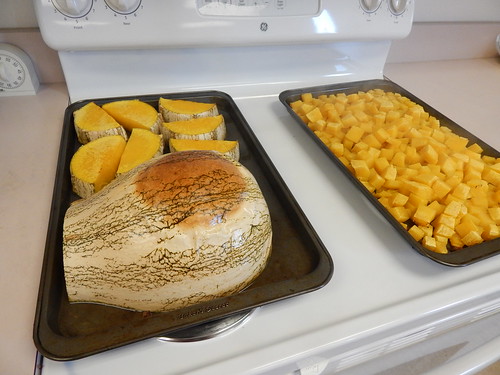
This is just a portion of the Green Striped Cushaw. It is really tasty! It is always a good start when the vegetable that is insect and disease resistant is also flavorful. The cushaw has a nice yellow flesh.
 This is one of the ‘Fairy’ squash that has a much more orange colored flesh. We haven’t cooked it yet to compare flavors. SPOILER ALERT! We’re making this one into chili for Saturday.
This is one of the ‘Fairy’ squash that has a much more orange colored flesh. We haven’t cooked it yet to compare flavors. SPOILER ALERT! We’re making this one into chili for Saturday.
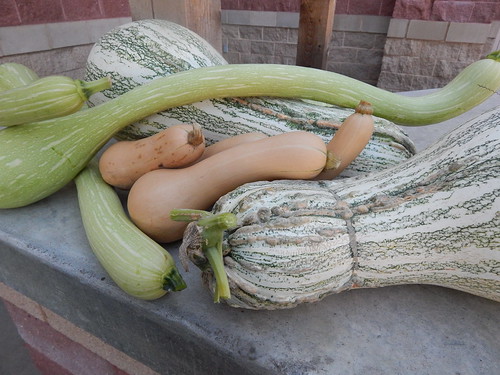 I guess we’re going backwards in time here. This is our “haul” from the garden this week. We harvested a bunch of butternut squashes, some tromboncino, and a couple more cushaws.
I guess we’re going backwards in time here. This is our “haul” from the garden this week. We harvested a bunch of butternut squashes, some tromboncino, and a couple more cushaws.
 Some of the lettuce survived the caterpillar onslaught and some didn’t. This plant survived, only to have a grasshopper hanging out in the center on Monday morning. If it isn’t one thing, it’s another!
Some of the lettuce survived the caterpillar onslaught and some didn’t. This plant survived, only to have a grasshopper hanging out in the center on Monday morning. If it isn’t one thing, it’s another!
 Sorry…I just had to break out a Swiss Chard photo to end the week. We’ve let it go for a couple weeks and it has gotten bigger quickly. It is one of the few things in the garden that is still looking spectacular!
Sorry…I just had to break out a Swiss Chard photo to end the week. We’ve let it go for a couple weeks and it has gotten bigger quickly. It is one of the few things in the garden that is still looking spectacular!
Have a great weekend!

